How Much Does a President Get Paid a Year How Much Does a Beef Cost
By Brian Deese, Sameera Fazili, and Bharat Ramamurti
The President understands that families have been facing higher prices at the grocery shop recently. Half of those contempo increases are from meat prices—specifically, beef, pork, and poultry. While factors like increased consumer demand take played a role, the price increases are also driven by a lack of competition at a central bottleneck betoken in the meat supply chain: meat-processing. Just four large conglomerates control the bulk of the market place for each of these three products, and the information testify that these companies accept been raising prices while generating record profits during the pandemic. That's why the Biden-Harris Assistants is taking bold action to enforce the antitrust laws, boost competition in meat-processing, and push back on pandemic profiteering that is hurting consumers, farmers, and ranchers across the country.
Meat constitutes one-half of nutrient at dwelling price increases. Large price increases for beef, pork, and poultry are driving the recent toll increases consumers are seeing at the grocery store (a measure commonly known as "nutrient at domicile"). Together, these three items account for a total half of the price increase for food at domicile since Dec 2020. Since that time, prices for beef have risen by 14.0%, pork by 12.1%, and poultry past vi.half dozen%.
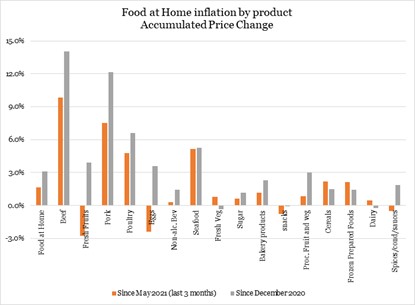
Four large conglomerates overwhelmingly command meat supply bondage, driving down earnings for farmers while driving up prices for consumers. The meatpacking industry buys cattle, hogs, and chickens from farmers and ranchers, processes information technology, and then sells beef, pork, and poultry on to retailers like grocery stores. The industry is highly consolidated, and serves as a key choke bespeak in the supply chain (see effigy beneath).
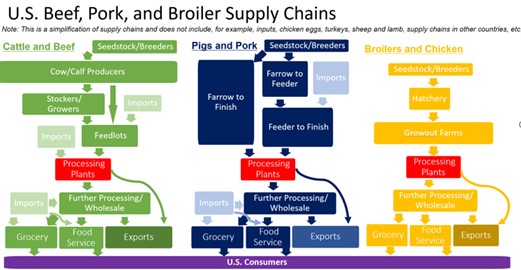
Today, just four firms control approximately 55-85% of the market for these three products, according to U.S. Department of Agriculture data. That reflects dramatic consolidation of the manufacture over the last five decades, as the large conglomerates have absorbed more and more smaller processors. In 1977, the largest 4 beefiness-packing firms controlled just 25% of the market, compared to 82% today. In poultry, the summit four processing firms controlled 35% of the marketplace in 1986, compared to 54% today. And in pork, the height four hog-processing firms controlled 33% of the market place in 1976, compared to 66% today.
That consolidation gives these middlemen the ability to squeeze both consumers and farmers and ranchers. There's a long history of these giant meat processors making more than and more, while families pay more at the grocery shop and farmers and ranchers earn less for their products. Absent this corporate consolidation, prices would be lower for consumers and fairer for farmers and ranchers.
The meat-processors are generating record profits during the pandemic, at the expense of consumers, farmers, and ranchers. The dynamic of a hyper-consolidated pinch point in the supply chain raises real questions almost pandemic profiteering. During the pandemic, wholesale prices for beef rose much faster than input prices for cattle. That means that the prices the processors pay to ranchers aren't increasing, simply the prices collected past processors from retailers are going up.
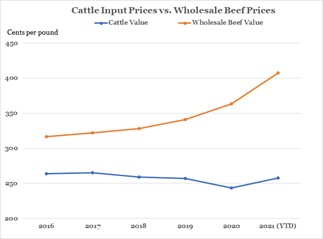
At the same time, we accept seen some of the height firms in this industry generate record gross profits and their highest gross margins in years. Gross profits for some of the leading beefiness, poultry, and pork processors are at their highest levels in history, and Q1 2021 and Q2 2021 were the most profitable quarters in history for some of these processors. Net income for many of these companies is on pace to reach historic highs too. (Other summit processors just don't report publicly on their profits, margins, or income.)
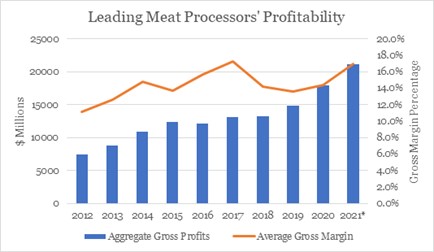
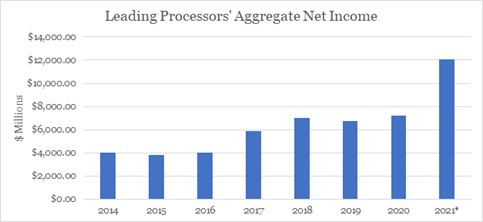
*2021 numbers are projected using the quarterly numbers reported this year.
These record profits, income, and margins underscore the role that meat-processors' ascendant marketplace position and power play in increasing meat prices. While factors similar consumer demand and input costs are affecting the marketplace, it is the lack of contest that enables meat processors to hike prices for meat while increasing their own profitability. That is, if they faced meaningful competition, the processors would just exist able to extract fewer profits if their costs had gone up unexpectedly while keeping prices lower to earn retailers' business.
Some of these companies have too been rewarding their shareholders with big dividends and buybacks during this period. For instance, the large processor JBS provided $2.3 billion in dividends and share buybacks in 2020. It has proposed record high dividend payments for 2021, increasing payouts to shareholders past near 75% over 2020. Similarly, Tyson recently raised dividends by half dozen% for fiscal year 2021, spending $477 meg on dividends in the nine months catastrophe July 2021. It besides repurchased $200 million of shares between September 2020 and July 2021.
These record profits and dividend payments come at a time when consumers are paying more than to put nutrient on the table, workers are risking their health and rubber to keep America fed, and farmers and ranchers are also facing unprecedented droughts, wildfires, and other extreme conditions events that put their herds and farms at risk. Meanwhile, taxpayers have made historic investments to help businesses keep their doors open and families cope with the economic impacts of this pandemic. These taxpayer investments take kept per capita need for meat steady, unlike the collapse in demand the meat industry experienced in the Great Recession.
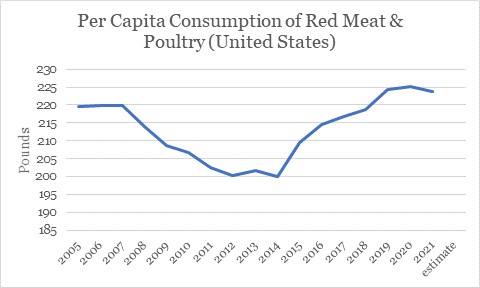
As we restart the world's largest economy and brand not bad strides in the economical recovery, the Biden-Harris Administration is committed to restarting correct for the American people—consumers and producers alike—by transforming the nutrient system. This is a pivotal moment of opportunity to build back a amend food system that is fair, competitive, distributed, and resilient.
The Biden-Harris Administration and USDA are taking on these issues past:
- Taking strong actions to crack down on illegal price fixing, enforce antitrust laws, and bring more than transparency to the meat-processing industry. USDA is conducting an ongoing articulation investigation with the Department of Justice into price-fixing in the chicken-processing manufacture, which has already yielded a $107 1000000 guilty plea by Pilgrim's Pride and numerous other indictments. USDA has also appear a more than robust Packers and Stockyards Act enforcement policy and new efforts to strengthen Packers and Stockyards Act rules, so that meat-processors can't use their market authorisation to abuse farmers and ranchers. And USDA is creating more transparency, with new market reports on what beef-processors pay, too equally new rules designed to ensure consumers become what they pay for when meat is labeled "Production of USA."
- Providing relief to minor businesses and workers hurt by COVID, and creating a more competitive nutrient supply chain. USDA will invest $1.4 billion in pandemic assistance to provide relief to small producers, processors, distributors, farmers markets, seafood processors, and food and farm workers impacted by COVID-19. This includes $700 million to attain small operations who have not received previous rounds of federal pandemic aid. USDA will as well provide $700 1000000 to states, tribes, and nonprofit organizations to distribute up to $600 per worker in relief payments directly to frontline farmworkers and meatpacking workers who incurred expenses preparing for, preventing exposure to, and responding to the COVID-19 pandemic. USDA will also invest $500 million in American Rescue Program Act funds to back up new competitive entrants to expand local and regional meat and poultry processing capacity. USDA will provide grants, loans, and technical assistance to create new meat and poultry processing capacity that volition compete with the big guys, forcing them to lower prices and really earn their business concern, and provide farmers and ranchers admission to better choices and fairer prices in local and regional food systems.
- Getting ahead of climate change related disruptions by supporting farmers and ranchers from the furnishings of extreme weather condition. Unprecedented drought and extreme weather condition events have brought new challenges for farmers, ranchers, and agronomical workers, on top of the celebrated challenges associated with the COVID-19 pandemic. To respond to the drought affecting farmers and ranchers across the West and Midwest, USDA will expand its Emergency Assistance for Livestock, Honeybees and Farm-Raised Fish Program (ELAP) to include the toll of transporting feed, delivering much-needed relief to affected livestock producers.
- Working with Congress to make cattle markets more than transparent and fairer. Right now, meatpackers accept outsized power in setting the prices for beef, which are oft prepare in opaque contracts that lock contained livestock producers into prices that aren't the product of free and fair negotiation. The Assistants is encouraged to see bipartisan legislation by Senators Tester, Fischer, Grassley, Wyden, and others that seek to improve toll discovery in the cattle markets—and facilitate bodily negotiation of prices between livestock producers and packers. We expect forward to working with Congress on these important problems, and we promise that they will besides wait for ways to ensure farmers and ranchers have off-white access to meat-processing capacity.
All together, these actions will assistance build a food system that works for the American people higher up all else. They volition support families, farmers, and workers while preventing bad actors in the supply concatenation from lining their pockets and getting further ahead without accountability. This volition make the food system fairer and more than equitable, more than competitive and transparent, and more distributed and resilient against shocks. In plow, it will increase farmers' and ranchers' earnings, deliver greater value to workers, and offer consumers affordable, healthy food produced closer to home.
camfieldwrecertrecan.blogspot.com
Source: https://www.whitehouse.gov/briefing-room/blog/2021/09/08/addressing-concentration-in-the-meat-processing-industry-to-lower-food-prices-for-american-families/
0 Response to "How Much Does a President Get Paid a Year How Much Does a Beef Cost"
Post a Comment